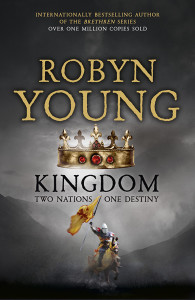The Artist’s War: Robyn Young’s Insurrection Trilogy
by Gordon O'Sullivan
 “I find writing a historical novel rather like a dot-to-dot painting, where many unconnected points have to be joined with lines the novelist must create in order to give a full picture.” In Kingdom, the final novel in her medieval Insurrection trilogy, Robyn Young has painted the medieval world of Robert Bruce with the verisimilitude of a war artist.
“I find writing a historical novel rather like a dot-to-dot painting, where many unconnected points have to be joined with lines the novelist must create in order to give a full picture.” In Kingdom, the final novel in her medieval Insurrection trilogy, Robyn Young has painted the medieval world of Robert Bruce with the verisimilitude of a war artist.
This new novel, so new that this is actually Young’s first interview for Kingdom, brings to a thrilling conclusion Bruce’s long journey to be crowned king of an independent Scotland. In Kingdom, “he’s literally been stripped down to the shirt on his back” and he’s “forced to ‘take to the heather’ with his surviving men” relying “on men and women from every social class and from all across his kingdom.”
Bruce is an extremely complex hero, brutal and deceitful yet inspirational and unimaginably brave. That complexity drew Young to him. “He isn’t your typical hero. He’s the victorious rebel who gains a crown only to lose everything else. The broken man who is forced to build himself back up from nothing, learning courage, humility and passion. The good king who leads his people to freedom.” But it isn’t just Robert’s character that drives this trilogy. Young renders authentic and intimate portraits of Bruce’s enemies – a real challenge “to create individual voices in such a large cast of characters – especially when so many of them have the same name! I did my dramatis personae for Kingdom last week and discovered there are 130 characters in the novel, 92 of them real people.”
The battle of Bannockburn has taken on considerable political significance this year with its 700th anniversary and the Scottish independence vote. Bannockburn is also Kingdom’s climax and its contemporary significance was just as important for Scotland. Young contends that “this remarkable victory cemented Robert’s position as king in the eyes of the Scots… the English, under Edward II, were forced out of Scotland and… negotiations led, in 1328, to the Treaty of Edinburgh and the securing of Scotland’s independence from England.” Not bad for a battle that lasted a couple of hours.
In Kingdom, the texture and pacing of Robyn Young’s battle scenes are extraordinary, Bannockburn in particular is riveting, but those qualities were not achieved solely through the customary book research and site visits. Young is not an armchair general, finding hands-on research invaluable: “When I started Insurrection I spent a year being taught to ride by a skill-at-arms instructor, which gave me new respect for the skill of my knights. I also wore mail and tried my hand at sword fighting and archery.” The clarity on the page is not without cost. Says Young, “I usually find battle scenes tough. It can be a draining experience immersing yourself in these hellish events, imagining what your characters would have felt, witnessed, heard, even smelled and tasted. My partner says he always knows when I’ve been writing a battle scene because I come out of my study pale and drawn.” This is all so readers can “feel as if they’re there, however repulsive or uncomfortable a place it is.”
Now that the last trumpet has sounded for Robert Bruce, Robyn Young’s mind is already on a new series: “the Renaissance Series (working title) is due to be set in the period between the end of the Wars of the Roses and the birth of the Tudors and will follow soldier of fortune, Jack Vaughn, across war-torn Europe. It’s another time, like the Crusades, when nations were clashing and struggling for supremacy and the world was opening up. You’ve got war and intrigue, great power struggles, quests for new lands, towering kings and queens – all great material for the historical wordsmith!” Or dot-to-dot artist.
Kingdom, Book 3 of the Insurrection Trilogy, will be published by Hodder & Stoughton UK on 5 June 2014.
About the contributor: Gordon O’Sullivan is a digital project manager and a reviewer for the HNR.
______________________________________________
Published in Historical Novels Review | Issue 68, May 2014






